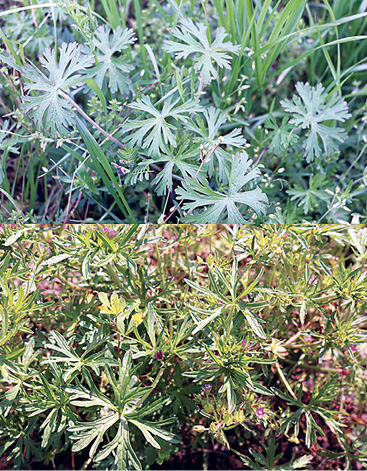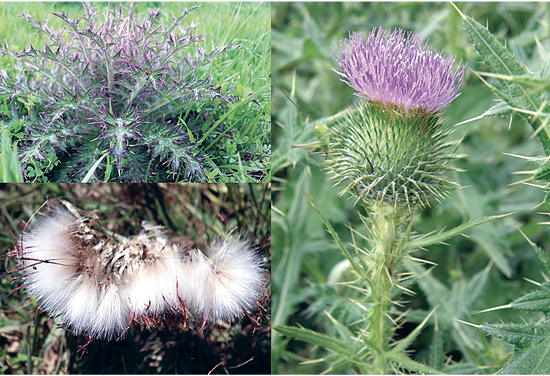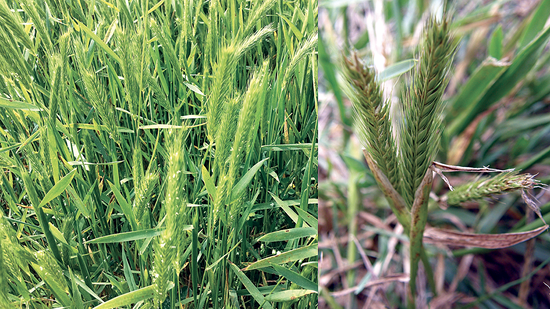Identifying Common Winter Weeds in Pastures
Winter annual weed competition can be damaging to early-spring forage yield. Most winter annual weeds will germinate in late fall, grow during the winter, and reach a reproductive stage in the early spring, when they compete with desirable forage species. As temperatures increase, the weeds become more problematic and then senescence (die), leaving behind seed that will germinate the following fall.
Weed-control decisions in pastures are usually based on visual thresholds and making sure that you can target as many weed species as possible with a broad-spectrum herbicide application. Always scout fields to determine if a treatment is warranted. Herbicide selection, application rate, and application time depend on the growth stage of the target weed species.
Weeds are considered an important biotic constraint to pasture management. Integrated weed management for pastures combines the use of complementary weed-control methods such as grazing, herbicide application, and mechanical and biological control. This publication concentrates on chemical control for specific cool-season weed species. Some of the most common troublesome winter weeds include buckhorn plantain, buttercup, Carolina geranium, common chickweed, curly dock, dandelion, henbit, musk thistle, and wild barley. Table 1 at the end of this publication contains a number of herbicides with activity on winter pasture weeds.
Buttercup
Buttercup (Ranaculus sardous), an annual broadleaf weed with deeply lobed leaves, is also known as crowfoot. It has a fibrous root system or thickened rootstock or bulbs. The green stem can be a single stalk, or it can branch from the base with hairs. The leaves form a rosette at the base of the plant. The leaves in the stem are usually alternated, lobed, or divided. Buttercup produces shiny, golden-yellow flowers with five petals and five green sepals. Buttercup can be toxic to all livestock species due to an irritant oil called protoanemonin. The plant releases this toxin when it is chewed or wounded. Both stems and leaves contain the toxin. Mature, flowering plants contain greater toxin concentrations than younger plants do. Buttercup toxicity is uncommon in cattle because the weed is usually unpalatable. However, it can occur when there is a short supply of forage for cattle to consume. Some signs of toxicity include colic, convulsions, abdominal pain, severe diarrhea, and blistering of the mouth and internal parts of the ruminal tract. In severe cases, it can cause death. In lactating cows, the milk is bitter and may have a reddish color. Buttercup toxicity in hay should not be a concern since the toxin becomes inactivated or less toxic when dried. Although weather conditions can vary each year, herbicide applications should be made from late February to early March during active foliar growth and before bloom stage.

Buckhorn Plantain
Buckhorn plantain (Plantago lanceolata), a perennial broadleaf winter weed, is also known as ribwort plantain, narrowleaf plantain, English plantain, ribleaf, and lamb’s tongue. It has a simple or branched taproot. Plantain forms a basal rosette with football-shaped leaves that have short hairs and prominent parallel veins. They produce short flowers in a stalk from April to August. Flower heads are usually egg-shaped. The seeds are black and boat-shaped; one side of the seed is rounded and glossy with a light-brown stripe. Buckhorn plantain is drought tolerant. The best time to control buckhorn plantain is from March to April.

Common Chickweed
Common chickweed (Stellaria media), a long-growing annual broadleaf, is also known as winterweed, common startwort, or startwort. It has a shallow, fibrous root system with a weak taproot. The light-green leaves are smooth or hairy towards the base of each leaf stalk. Leaves usually have an opposite arrangement on the stem with a small oval or elliptical shape. Stems are covered with rows of hairs in the older portions. Chickweed can have solitary white flowers or small clusters at the end of their stems. The best time for control is usually from November or mid-February to mid-March.

Curly Dock
Curly dock (Rumex crispus), a perennial winter broadleaf weed, is also known as sour dock or yellow dock. It has a deep, yellowish-orange taproot. Leaves are dark green with wavy margins, and they form a basal rosette. Leaves in the lower part of the rosette have margins with crimped undulations without hairs. Leaves have an alternate arrangement along the stem, and the joint where they meet is wrapped by a membranous sheath. As the plant ages, its leaves become reddish-purple. The seed head is a panicle that forms at the end of the stem. Weed control is more difficult as the plant matures because of the deep taproot system. The best time for control is from mid-February to late March.

Cutleaf Geranium
Cutleaf geranium (Geranium dissectum), a winter annual broadleaf weed, is also known as wild geranium or cranesbill. It has a shallow taproot with fibrous roots. The stem is very hairy, pink to red in color, and erect with branching near the base. Leaves are deeply cut and divided with toothed segments. Flowers with whitish-pink to pale-purple petals are usually found at the tips of the stem and branches in compact clusters. The fruit resemble a distinctive crane’s bill. Plants typically do not persist after flowering. The best time for control is usually from late November or mid-February to mid-March.

Dandelion
Dandelion (Taraxacum officinale), an aggressive perennial broadleaf weed, is also known as puffball, lion’s head, and monk’s head. Its zig-zag leaves grow in a flat, basal cluster. A hollow flower stalk secretes a white, milky sap when broken. Dandelions are easily recognized by their bright-yellow flower heads, which can transform into white seed heads. The seeds can be spread easily by wind due to their light, parachute-like structure. This weed is commonly found growing in areas with good drainage and direct sunlight. Because of their need for direct sunlight, the presence of dandelions in pastures often indicates overgrazing or poor soil fertility. The best time for control is from October to November or March to April.

Henbit
Henbit (Lamium amplexicaule), an annual winter broadleaf weed, sometimes gets confused with purple nettle. Along with buttercup, it is probably one of the most common winter annual weeds in annual ryegrass pastures. Henbit has a fibrous root system. The plant has rounded or triangular leaves and hairy, green or purplish square stems with ascending branches. The leaf margins have rounded lobes with very distinctive veins. Leaves tend to be dark green above and light green below. Henbit has bright-pink/purple flowers with long necks. It can grow to heights of 12 to 16 inches. Henbit is a shade-resistant weed that can survive well under small grain or annual ryegrass pastures. The herbicide 2,4-D alone is usually not very effective for controlling henbit. The best time for control is usually from late November or mid-February to mid-March.

Musk Thistle
Musk thistle (Carduus nutans), a biennial winter weed, is also known as nodding thistle or nodding plumeless thistle. It has a fleshy taproot. Basal rosettes are usually well developed, and dark, waxy green leaves alternate and are deeply lobed with spiny, white margins. Leaves also have distinctive light-green midribs. Single or multiple stems may develop from the basal rosette and can be highly branched near the top. Most flowers appear in late May to early June. Flowers, which form at the top of the stem, can be deep rose, violet, purple, or occasionally white with lance-shaped spine bracts at the base. Seeds are long, shiny, and yellowish brown with plumes of white-like bristles. Seed can mature and be dispersed by wind one to three weeks after flowering. Musk thistle prefers moist, bottomland soil, but it can also be found on drier uplands. It is a prolific seed producer—approximately 10,000 seeds per plant. A single plant can produce up to 100,000 seeds in one season, and they can remain viable in the soil for up to 10 years. There are different types of thistles (bull, tall, Canada, sow thistle) that can be very invasive. They should be controlled during the winter or very early spring while in the rosette stage for better control. The best time for controlling thistle is from mid-February to April before bloom.

Wild Barley
Wild barley (Hordeum pusillum), a short winter annual grass, is also known as foxtail barley or little barley. This shallow-rooted bunchgrass resembles wheat or barley at maturity and can persist in most soil types. Seeds germinate at the soil surface in cooler fall weather, but seedlings are common in the spring. Mature leaves are evenly spaced, flat blades with fine hairs along the edges and a membranous ligule at the collar. The leaf sheath has split, overlapping, and translucent margins. Stems are slender and erect, forming very distinguishable seed heads by late spring. Seed heads form identifiable spikes with long, fine needlelike awns or bristles that can poke the mouths of livestock. Seed heads turn brown upon maturity and are dispersed by wind, animal, and equipment movement. Seed viability declines rapidly after three years. In established grass pastures, little barley can be controlled with pendimethalin (preemergence) applied in the fall. Little barley may also be controlled with nicosulfuron plus metsulfuron in bermudagrass pastures if applied before the mid-boot stage in early March to early April.

Wild Garlic
Wild garlic (Allium vineale) is a perennial cool-season broadleaf. It has narrow, round, and hollow leaves usually in clusters of two to four leaves. The root system consists of bulbs enclosed in a papery, membranelike skin. Wild garlic plants are classified in two categories: 1) plants that produce a flowering stem or leafless peduncle (scapigerous plants) and 2) those that do not produce a flowering stem (nonscapigerous). The flowering stem is slender, waxy, solid, and unbranched. Flowers form at the top of the short stems and are small and greenish-white. Fruit consists of a three-parted, egg-shaped capsule. Wild garlic can reproduce by underground bulbs, aerial bulblets, or seed (although this a minor pathway for plant dispersal). Wild garlic produces several types of underground bulbs, including offset bulbs (only in scapigerous plants), central bulbs (nonscapigerous), and hard-shell bulbs. Each season, the weed can produce up to six hard-shell bulbs, which are located immediately adjacent to the original bulb. When fully formed in the spring, bulbs can sprout the following fall and survive dormant for up to six years. The best time for control is from October to November or March to April.

|
Herbicide |
Buckhorn Plantain |
Buttercup |
Cutleaf Geranium |
Common Chickweed |
Curly Dock |
Dandelion |
Henbit |
Musk Thistle |
Wild Barley |
Wild Garlic |
|
2,4-D |
X |
X |
X |
X |
X |
X |
X |
X |
X |
|
|
Aminopyralid |
X |
|||||||||
|
Chlorsulfuron |
X |
|||||||||
|
Dicamba |
X |
X |
X |
X |
||||||
|
Diuron |
||||||||||
|
Imazapyr |
X |
|||||||||
|
Glyphosate |
X |
X |
X |
X |
||||||
|
Metsulfuron-Methyl |
X |
X |
X |
X |
X |
|||||
|
Paraquat |
X |
X |
X |
X |
||||||
|
Picloram |
||||||||||
|
Sethoxydim |
X |
|||||||||
|
Sulfosulfuron |
X |
|||||||||
|
Triclopyr |
X |
|||||||||
|
2,4-D + Aminopyralid |
X |
X |
X |
X |
X |
X |
X |
X |
X |
|
|
2,4-D + Dicamba |
X |
X |
X |
X |
X |
X |
X |
X |
||
|
2,4-D + Glyphosate |
X |
X |
X |
X |
||||||
|
2,4-D + Picloram |
X |
X |
X |
X |
X |
|||||
|
2,4-D + Triclopyr |
X |
X |
X |
|||||||
|
Aminopyralid + Metsulfuron |
X |
|||||||||
|
Diflufensopyr + Dicamba |
X |
|||||||||
|
Imazapyr + Metsulfuron |
||||||||||
|
Picloram + Fluroxypyr |
X |
|||||||||
|
Metsulfuron + Dicamba |
X |
X |
X |
X |
X |
|||||
|
Nicosulfuron + Metsulfuron |
X |
X |
||||||||
|
Triclopyr + Clopyralid |
X |
X |
X |
X |
X |
X |
X |
|||
|
Triclopyr + Fluroxypyr |
X |
|||||||||
|
Metsulfuron + 2,4-D + Dicamba |
X |
|||||||||
|
Nicosulfuron + Metsulfuron + Glyphosate |
X |
Due to the chemical composition of herbicides, it is always important to read labels before handling, mixing, or applying the chemicals. It is equally important to practice good stewardship. Legumes such as clovers interseeded with cool-season grasses can be severely injured or killed by herbicide products used to control troublesome winter weeds. Postemergence herbicide applications should be made when weeds are actively growing and winds are between 2 and 10 miles per hour. Preemergence herbicides previously mentioned need rainfall after application for soil incorporation and activation. Several of the herbicides used in forage production usually have grazing and haying restrictions associated with the applications. For more information, please consult the forage section of Extension Publication 1532 Weed Control Guidelines for Mississippi.
Disclaimer: There are often several species of most of these weeds in Mississippi that also can be troublesome in pastures, and the same herbicides could provide similar activity.
References
Abaye, A. O. (2010). Identification and adaptation: Common grasses, legumes & non-leguminous forbs of the eastern United States. (Chamblee D. S., & Wieboldt, T., Eds.). Interstate Graphics.
Alabama Cooperative Extension System. (2023). Pastures and forage crops IPM guide. IPM-0028.
Bryson, C. T., & DeFelice, M. S. (Eds). (2009). Weeds of the south. University of Georgia Press.
Colvin, D. L., Dickens, R., Everest, J. W., Hall, D., & McCarty, L. B. (2004). Weeds of southern turfgrasses. University of Georgia Cooperative Extension Service. Special Bulletin 31.
Dow AgroSciences. (2014). Range & pasture weed ID guide.
Green, J. D., Witt, W. W., & Martin, J. R. (2006). Weed management in grass pastures, hayfields, and other farmstead sites. University of Kentucky Cooperative Extension Service. Publication AGR-172.
Marshall, M. (2018). “Grass forage weeds control.” In South Carolina pest management handbook for field crops. South Carolina Cooperative Extension Service. Publication APT-18.
Mississippi State University Extension Service. (2023). Weed control guidelines for Mississippi. Publication 1532.
Spearman, B., Shooter, M., Conrad-Acuña, T., Wells, D., & Wood, R. (2009). Weed identification in pastures and hayfields. North Carolina Cooperative Extension Service. Publication AG-764W.
Syngenta Crop Protection Inc. (2005). Southern weed guide.
University of Missouri, Division of Plant Sciences. (n.d.) Weed ID guide.
USDA, NRCS. (n.d.). The PLANTS Database. United States Department of Agriculture.
Uva, R. H., Neal, J. C., & Ditomaso, J. M. (1997). Weeds of the northeast. Cornell University Press.
Virginia Tech, College of Agriculture and Life Sciences, & Virginia Cooperative Extension. (n.d.) Weed identification guide.
Publication 3228 (POD-05-24)
By Rocky Lemus, PhD, Extension/Research Professor, Plant and Soil Sciences.
The Mississippi State University Extension Service is working to ensure all web content is accessible to all users. If you need assistance accessing any of our content, please email the webteam or call 662-325-2262.




